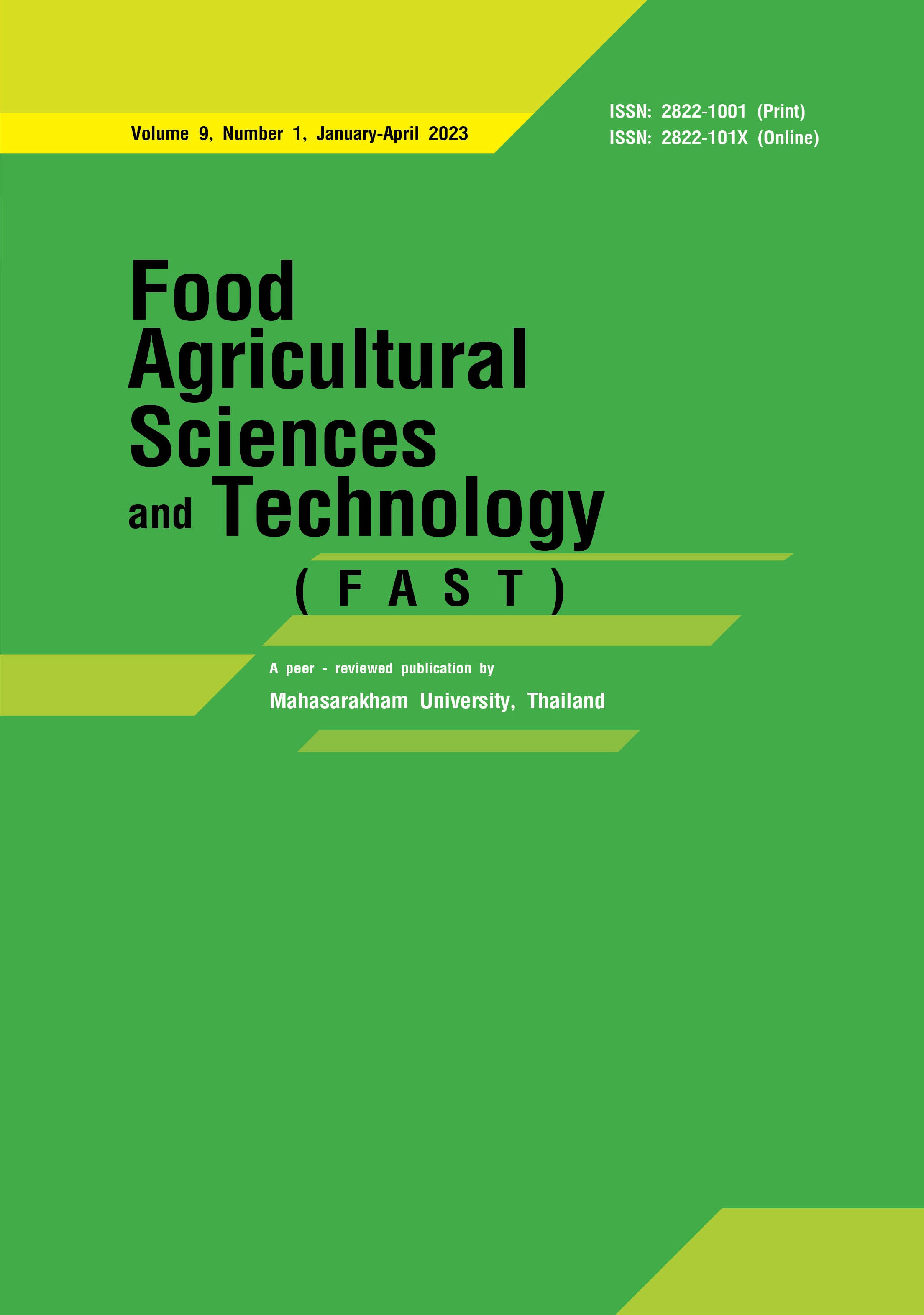Microbial communities and key strains associated to banana spoilages through cultural plating and metagenomic analysis
Keywords:
Cultural plating, banana spoilages, metagenomic analysisAbstract
This research investigated microbial communities associated to bananas spoilage by cultural plating and metagenomic analysis. Bananas were collected from three different sources including exported farm, domestic organic farm and marketed bananas. Bacteria and fungi on fresh through spoiled banana surfaces were determined. It was found that microbial communities observed from both methods were significantly different. Microbial communities on fresh and spoiled bananas observed from each method were relatively different. From cultural plating, bacteria observed on almost fresh bananas and spoilage, from export, domestic farms and wholesale fruits market, was Enterobacter ludwigii. Fungus, Penicillium citrinum was mainly observed from all fresh and spoiled bananas from marketed fruits. Aspergillus inflatus was mainly observed on spoiled bananas collected from export farm but was not found in domestic farm and marketed fruits. From metagenomics analysis, the most abundant bacteria on fresh and spoiled banana surface was Enterobacteriacae and Pantoea, respctively. Moesziomyces made up the largest division in both fresh and spoiled bananas. Information obtained also demonstrated that geographical factors had less impact on microbial flora associated to fruit spoilage. There was no specific microbial community pattern observed on banana collected from farms. Similar microbial profiles associated to the spoilage of banana collected form market were observed. Thus, data obtained could reinforce the importance of analytical methods for studies on the microbial ecology of banana and highlight the need for more detailed examination of this variable and its importance in post-harvest management.
References
Aljasass, F. M., Aleid, S. M., & Hamad, S. H. (2016). Potential pathogenic yeasts isolated from fresh date fruits (Rutab). Pakistan Journal of Agricultural Sciences, 53(2).
Dukare, A. S., Paul, S., Nambi, V. E., Gupta, R. K., Singh, R., Sharma, K., & Vishwakarma, R. K. (2019). Exploitation of microbial antagonists for the control of postharvest diseases of fruits: a review. Critical reviews in Food Science and Nutrition, 59(9), 1498-1513.
Forbes, J. D., Knox, N. C., Ronholm, J., Pagotto, F., & Reimer, A. (2017). Metagenomics: the next cultureindependent game changer. Frontiers in microbiology, 8, 1069
Handelsman, J., Rondon, M. R., Brady, S. F., Clardy, J., & Goodman, R. M. (1998). Molecular biological access to the chemistry of unknown soil microbes: a new frontier for natural products. Chemistry & Biology, 5(10), R245-R249.
Hakim, S., Liaquat, F., Gul, S., Chaudhary, H. J., & Munis, M. F. H. (2015). Presence of Bacillus pumilus causing fruit rot of Ficus lacor in Pakistan. Journal of Plant Pathology, 97(3).
Harrigan, W. F., & McCance, M. E. (1976). Laboratory methods in food and dairy microbiology. Academic Press Inc.
Salas, M. L., Mounier, J., Valence, F., Coton, M., Thierry, A., & Coton, E. (2017). Antifungal microbial agents for food biopreservation—A review. Microorganisms, 5(3), 37.
Masyahit, M., Sijam, K., Awang, Y., & Ghazali, M. (2009). First report on bacterial soft rot disease on dragon fruit (Hylocereus spp.) caused by Enterobacter cloacae in peninsular Malaysia. International Journal of Agriculture and Biology, 11, 659-666.
Office of Agricultural Economics. (2021, January 21). Main agricultural exports. Office of Agricultural Economics.
Okonkvvo, U. N., Amund, O. O., & Ogunsanya, C. O. (1990). Microbial rotting and preservation of banana fruits (Musa sapientum L.) in Nigeria. Microbios Letters, 44.
Oyewole, O. A. (2012). Microorganisms associated with deterioration of stored banana fruits. Frontiers in Science, 2(5), 86-91.
Palejwala, V. A., Patki, C. K., Bhatt, S. V., & Modi, V. V. (1987). Post-harvest spoilage of mangoes by Aspergillus niger. International Journal of Food Microbiology, 5(2), 111-116.
Paulino, L. C., Tseng, C. H., Strober, B. E., & Blaser, M. J. (2006). Molecular analysis of fungal microbiota in samples from healthy human skin and psoriatic lesions. Journal of Clinical Microbiology, 44(8), 2933-2941.
Song, J. H., Wu, Z. R., Zhang, L. X., Tan, G. J., Wang, S., & Wang, J. J. (2018). First report of Bacillus pumilus causing fruit rot on muskmelon (Cucumis melo) in China. Plant Disease, 102(2), 439-439.
To, H. T. A., Chhetri, V., Settachaimongkon, S. & Prakitchaiwattana, C. (2021). Stress tolerance-Bacillus with a wide spectrum bacteriocin as an alternative approach for food bio-protective culture production. Food Control, 133, 108598.
Trevors, J. T. (2011). Viable but nonculturable (VBNC) bacteria: gene expression in planktonic and biofilm cells. Journal of Microbiological Methods, 86(2), 266-273.
Yumbya, P., Ambukoa, J., Hutchinsona, M., Owinoc, W., Juma, J., Machuka, E. & Mutuku, J.M. (2021). Transcriptome analysis to elucidate hexanal’s mode of action in preserving the post-harvest shelf life and quality of banana fruits (Musa acuminata). Journal of Agriculture and Food Research, 3, 100114.
Downloads
Published
How to Cite
Issue
Section
License
Copyright (c) 2023 Food Agricultural Sciences and Technology (FAST)

This work is licensed under a Creative Commons Attribution-NoDerivatives 4.0 International License.








